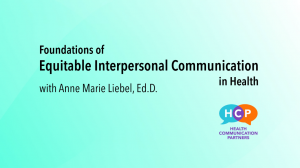We have two big announcements: our brand new, dedicated course platform, and a new communication course for anyone who interacts with patients. Learn more about them both!
Today’s the day. For months I’ve been saying we have a big announcement to make, and today I finally get to share it with you. Really excited about this, so I’m going to jump right into it.
Hi everybody, this is “10 Minutes to Better Patient Communication” from Health Communication Partners. I’m Dr. Anne Marie Liebel.
And we have not just one but two big announcements. So I’m going to go right into it. The first one is on our Health Communication Partners website. We’ve added a dedicated course platform. That’s a dedicated space, where nothing happens but teaching and learning. And we’re going to debut this space with a new course. That’s our second big announcement.
We have a brand new video based course called “Foundations of Equitable Interpersonal Communication in Health.” And it is available right now!
You know me well enough by now, I’m going to cut to the chase: four things that you need to know about this course.
It centers culture
First of all, it centers culture. There are plenty of communication courses out there, I know. Why did I make one? Well, because people asked me to. People who’ve worked with me, people like you who listen to the show, pointed out what I’m doing that’s different and valuable to them. And you know I’ve been consulting for years and years. So I made this course in response to some of the most common questions that I get about communication, and some of what I’ve shared that people tell me they appreciate most.
And a lot of it boils down to this: the way I handle the complex connections between communication and culture.
One thing that sets this course apart is that it teaches you to recognize and bridge cultural differences that can contribute to miscommunication. Because we know a lot of avoidable problems that contribute to health inequalities wind up manifesting through communication. And you can’t separate communication from culture. I don’t know why sometimes people pretend like you can.
What do I mean by culture? Sure, culture can refer to the world language that you speak, so we talk about that in this course. It could also refer to what social groups you are part of. It can refer to organizational culture as well. So in this course we talk about culture and we inquire into culture in multiple ways. Because all of this matters to communication.
It’s for all patient-facing employees
Another facet of this course that I am incredibly proud of, and really I think you’ll find is quite unique, is that it’s for all patient-facing employees. I’m not even kidding about this. This course is for anyone who interacts with patients. And as much as the content of the course was years in the making, the design has been too. And I’m incredibly proud of that, because I worked hard to make it appropriate for a wide audience, from surgeons to security guards!
This also include people with varying degrees of comfort with some of the topics, like bias, equity, even culture, even communication. You know I’ve been in this field awhile. I’ve spent years working with medical staff, hospital staff, public health professionals, at large and small organizations, rural and urban, and all of these experiences inform the content of this course. Including what I’ve learned from research, obviously, and my own work on vaccine communication during COVID.
I bring world class instructional design and pedagogic expertise to these demanding topics.
It’s reflective practice
A third thing I want you to know: it’s reflective practice. Not a surprise. But this course is not top-down. It’s not gonna to teach you to be top-down in your communication, either. And that is something that people tell me again and again that they appreciate. Throughout the course, I invite you to think about your communication, your culture, your professional role.
The focus is on communicating with patients, but I also deal with interprofessional communication. Because again the course is called “Foundations of Equitable Interpersonal Communication in Health.” We do make a nod to organizational communication as well. And then turn to action! Because you know how I do reflective practice. It’s not just thinking for the sake of reflecting. It always turns to action at the end.
It’s on our new course platform
Fourth thing I want you to know is that it’s on our gorgeous new course platform.
And this is important because you’re not just watching some stuff on youtube! This is serious content. This is demanding work.
That is why we have a new, dedicated course platform. I made this platform clean and distraction-free because I want you to have the best learning experience possible. So the course looks elegant on any device. And it’s easy to navigate. It can also work within your organization’s existing course platform.
Because the course is a series of short videos, and resources, and readings, and links. You can watch at your own pace, stop and pick up where you leave off. And if you watched all the videos together, end-to-end, it would take about an hour.
Now there’s so much more I could say, so I’ve gone ahead and made an overview video. And I’ll put links in the show notes. This course is interactive, it’s experiential, it’s practical, and it’s only available to organizations. Because this is about sustainable change at individual and systems levels.
Now for more information, visit healthcommunicationpartners.com. You can also find me on the social, on twitter and linked. And write me, Annemarie at h-cpartners.com. This has been “10 Minutes to Better Patient Communication” from Health Communication Partners. Music and audio engineering by Joe Liebel. I’m Dr. Anne Marie Liebel.

